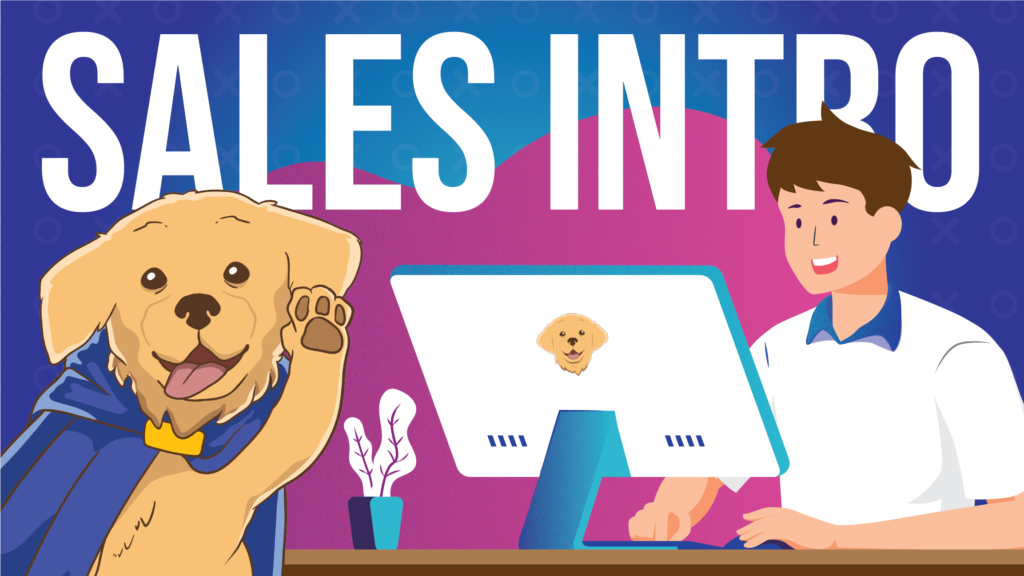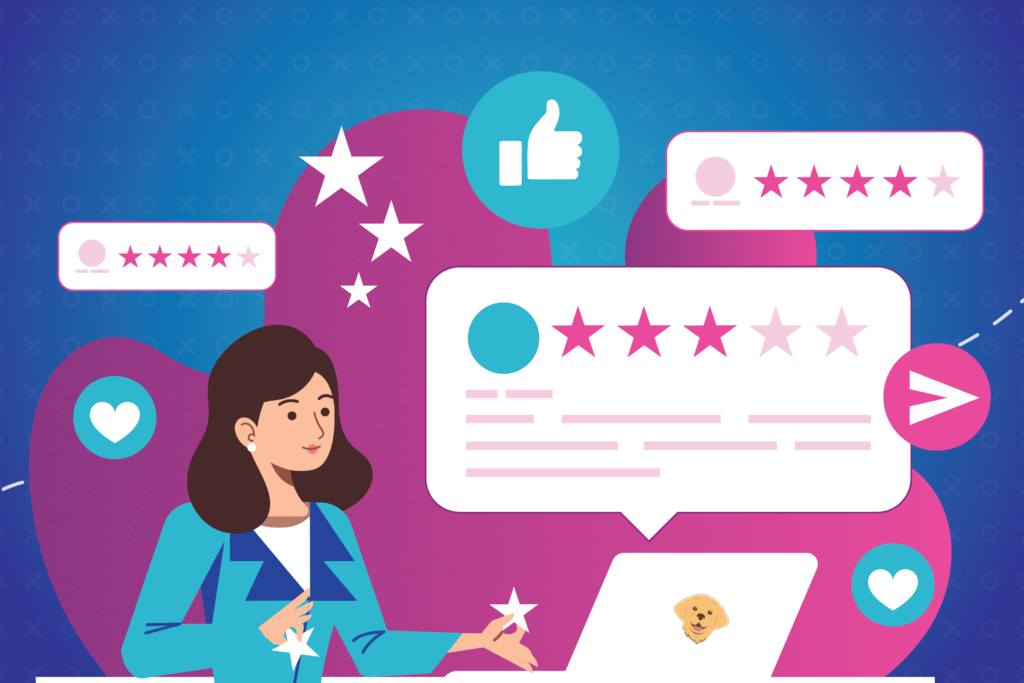How to Write an Irresistible Sales Introduction Email (with Templates)

How often do you get stuck trying to write an email introducing yourself or your product to a prospect?
Note that I didn’t ask whether you get stuck writing introductory emails at all. I know very well that you do.
And how do I know this?
Well, because you’re not the only one experiencing this problem. In fact, most salespeople I know mention their struggles with writing sales introduction emails to one degree or another.
It makes sense.
You are emailing a near-stranger, after all, and want to get them excited about your business, your product, or to meet you. That’s a darn hard thing to do.
Pretty. Darn. Hard.
Good news – In this guide, you’ll discover advice that will help you make this task a little bit easier. We’ll discuss how to write an irresistible sales introductory email. Plus, I’m also going to show you introductory sales email templates that you could use in your sales campaigns right away.
Let’s get right to it, shall we?
But Hold On, What the Heck is a Sales Introduction Email?

You know – As salespeople, we face quite a challenge every single day. The challenge relates to the fact that most of the time, the job of connecting with someone, making a strong first impression, and starting an engaging conversation with them falls directly on us.
And yes, I appreciate that, from time to time, you get a warm lead and close the deal quickly. In most cases, however, you do have to build such a connection from scratch, right?
That’s exactly where a sales introductory email comes in.
As the name suggests, a sales introductory email is the very first message you send to a prospect to tell them about yourself, your product, or the business. The message, typically, starts your cold email strategy (although, as you’ll shortly see below, you can use it for other purposes as well.)
Overall, your goal for sending it is to introduce yourself but also to start a professional conversation with them.
(A side note – That’s also why writing introductory emails for sales is so difficult. Not only do you have to inform but also engage to a point to make a prospect want to converse with you further.)
When we use this term – sales introductory email – we often refer to a range of different introductory messages you might be sending to potential customers. In fact, there are at least five unique scenarios where you might need to send such an email:
- As a sales rep, you might need to introduce yourself or your business to a new client to kickstart the conversation.
- You might also need to introduce a new member of your sales team to existing clients or tell them about a new point of contact.
- You might be sending an introduction to yourself or the company as a follow-up to a referral by a mutual connection.
- Or, the email is a recap of a quick chat you and the prospect had at an event.
- Finally, your company might also be sending emails to introduce a new product or service.
Luckily, in spite of having different reasons for sending sales introductory emails, you can follow the same principles when creating and writing them.
How to Write an Irresistible Sales Introductory Email (With Templates and Examples for Inspiration)
What you’ll see below are the most important factors to keep in mind when writing introductory emails for sales.
For each factor, I included a template or a suggestion to help you implement it right away in your sales process.
So, without any further ado, here are eight factors that will help you write a stunning introductory email.
#1. Start with a catchy subject line
I know – You’ve probably, heard so much about email subject lines that you really can’t stomach another piece of advice on it.
But there is a reason why everyone’s talking about them. Without a catchy subject line, your chances for prospects to even open your email are pretty slim. And unless they open it, there’s zero chance that they’re going to read your introduction.
Your challenge – The email you send battles for prospects’ attention with all the other messages in their inbox. But unlike many of those emails, your has come from someone they don’t know. So, their motivation for even considering opening it is already small.
The subject line is your first chance at grabbing their attention.
Don’t take my word for it. According to this report, for example, 35% of email recipients decide whether to open an email or not by evaluating the subject line alone.
So, how do you convince recipients that your email is worth opening with just the subject line?
Here are a couple of suggestions:
- Use personalization
- Communicate the value included in the email
- Don’t provide all the information; arouse the prospects’ curiosity
Templates to use for introductory email subject lines:
- Quick question?
- A small favor?
- X Tips to Help Overcome [Prospect’s Challenge] in 2022
- A complete guide to [Prospect’s Challenge]
- Hello from [Your company name]
- For [Your company name]?
Example:

#2. Pack the punch with an email introduction
The subject line convinced your recipient to open the email. But, as I stated in my guide to writing email introductions, that’s not even half the battle won:
Even if you convince a prospect to open your message, you still need to make them read it, right? And if you’ve ever tried cold outreach before, then you know it’s so darn tricky.
Luckily, there are ways to help you ensure that your opening sentence packs a punch. I outlined all of them in the aforementioned guide. Here, let me just share with you those that work particularly well for a sales introduction email.
Boosting the prospect’s ego
We all have egos, and we like them boosted from time to time. So, when trying to connect with a new contact and introduce your company or yourself, start by targeting their ego.
- Congratulate them on a recent achievement or success
- Reference their latest blog post or podcast episode (and referencing a podcast episode really shows that you have done your homework on them)
- Reference reading an interview with them and what you’ve learned.
- Ask them for advice
Here are some ideas of templates you could use:
- I heard on a podcast episode you did with [someone] that you were able to [reach some goal] by [what they did]. That was really inspiring stuff and I appreciated that insight
- Loved the article you wrote on [topic]. I thought your advice about [specific thing] was brilliant
- I saw that you are an influencer in the [industry] space, and was hoping I could get your advice on [topic]
Offering value
Another great way to start an introductory email is by telling the prospect why they should read it. In this type of communication, you do this by revealing a major benefit that the prospect could get from you.
Here are three templates you could use here:
- I’m reaching out because I realized that [the major benefit your company or product can deliver to the prospect]
- I noticed that [the prospect’s current situation]. I know [how this could be changed]
- Are you experiencing [the problem]? I think I know how we could overcome this and [share a result or potential ROI of engaging with you].
Evoking curiosity
You could also make the recipient curious about the information you included in the email body. I admit that this is, by far, the most difficult method to start an email. It’s also one of the most powerful ones.
To evoke that curiosity, you must say something that’s surprising and bold and will challenge the prospect’s beliefs.
The simplest way to do it is by sharing a bold and surprising claim and then adding a contradicting statement that focuses on what your company sells.
For example, if you were a consultant helping small businesses increase revenue by generating more referrals, you could start the introductory email like this:
Did you know that X% of small businesses spend a large chunk of their marketing budget on attracting organic traffic? Yet, their biggest growth opportunities have nothing to do with Google.
Such a statement will most likely make any business owner concerned with their marketing ROI to get at least a little bit curious. Reading statements like this, they’re bound to ask themselves whether they’re not burning through their funds and be eager to learn more.
A simple template to use:
[Bold and surprising claim] + [contradictory statement]
Humor
One problem with a lot of sales emails is that they can tend to look the same, following a typical pattern. These emails don’t stand out, can come off generic, and be much more likely to get deleted or sent to spam.
One way you can stand out and build a connection is by using humor. Disarm your recipient with a little charm, which will make them much more likely to want to engage with you. In my personal experience, inoffensive puns work pretty well.
Here are some examples of using humor in an opening:
- I have a quick question for you… what’s a pirate’s favorite thing about marketing? The aaaaaaaROI!
- You’ve never heard of me. Hi, I’m {{user_first}}. I got your email from top secret servers using a biorythmic metaspyder with a 100GB nutro-plasmic VPN that I…. Ok, I got it from the Internet.
#3. Build connection by targeting a shared interest or area of focus
Here’s the obvious – When sending an introductory email, you typically reach out to someone who has absolutely no idea who you are.
Sure, in some obscure scenarios, the prospect might have heard of you, or you two exchanged a quick chat at a conference or an event.
In most cases, however, you found the prospect while building outreach lists, and there hasn’t been any communication between you two so far.
But here’s something you might not know – The best way to connect with them isn’t by stating who you are. It’s by building a connection with a mutual interest. This can be something you and the prospect have in common – a mutual connection or a shared interest. But even if you have none of that, you can still use this technique by focusing on things that your prospect can relate to.
For example, if I were sending an introductory email, I could say something like this:
Hi [prospect name], Andy from Postaga – a sales email software – here. [prospect name], we recently reviewed 20000 emails our users have sent to determine what factors result in poor email open rates. I think you’ll find the results interesting.
How to find the prospect’s area of focus?
This is actually quite easy to do in this day and age. We all publish an incredible amount of information online, be it on social media sites like Twitter or our blogs. So, review what your prospect posts about often and use that to connect with them in your introductory email.
#4. Mention the reason for reaching out
You know – I’m amazed by how many sales introductory emails I receive that don’t tell me why the person’s reached out to me.
These people tell me what they want from me but never why they reached out.
And yet, that’s by far one of the most important elements of the entire email!
You’ve evoked the person’s curiosity and connected with them. Now, you need to tell them what you want.
Do you want to schedule a meeting or a phone call? Evoke their interest in you and start an email conversation?
Don’t be afraid to tell prospects why you are reaching out.
There is another reason for doing so – It will tell them what to do next. Otherwise, your prospect might not even realize why they should respond to you.
#5. Use social proof to communicate credibility

Let me begin by saying this – You don’t have to include social proof in your introduction emails.
But if you do, it can tremendously help you make an impact on the prospect.
Why? Well, for one, social proof helps the recipient realize your credibility. It helps you earn their trust too.
In short, it helps turn you – an unknown person – into someone potentially worth listening to. And in sales outreach, that’s a massive thing.
Your social proof can be as simple as a reference of the number of people using your product already, for example:
Hi [prospect name], my name is Andy Cabasso; I’m the co-founder of Postaga, a sales email software used by thousands of sales reps every month.
On the one hand, this introduction doesn’t include any of my personal achievements. On the other, it confirms something incredibly important to my prospects – that I co-created a highly-successful sales platform that so many people like them use regularly.
Other social proof that you could reference in your email include:
- Quotes and endorsements. Here’s a simple template you can use for that: [known influencer] named me [you can replace this with your product name] “[quote from the influencer”].
- Reviews.
- Client testimonials.
- Company statistics like the number of years in business, the number of satisfied clients, average client rating, etc.
#6. Add a clear and compelling call to action
Remember how we discussed telling the prospect your reasons for reaching out? The call to action helps you take the next step and tell them what you want them to do next.
Your CTA could prompt the person to schedule a meeting with you, provide additional info, request more information, etc.
The key to making the call-to-action work is to make it clear. Don’t rely on the prospect to figure out what to do next. Tell them and do it in the simplest way possible.
For example, if you want them to schedule a meeting with you, the call to action you included in your sales introduction email template could say:
[prospect’s name], if you’d like to know more about [your product or offer], let’s get together to discuss. You can book a time in my calendar by using this link: LINK.
I’m looking forward to chatting.
Worth to note: Contrary to a common belief, I didn’t just include a button to my calendar. Instead, I explained why the prospect should book the call (to learn more about my offer) and how to do so.
Three types of calls to action in sales emails
In sales emails, there are three types of calls to action:
- Specific (e.g. “Are you free to talk tomorrow at 12pm?”)
- Open-ended (e.g. “Do you have time to talk this week?”)
- Interest (e.g. “Are you interested?”)
Interestingly, the interest-based call-to-action statistically outperforms the open-ended or specific types of calls to action.
#7. Close the email with a professional signature
I can guarantee that once you capture their attention, prospects will scroll to your email signature to find out more about who you are.
This also means that the information they find there will affect their willingness to respond to your email.
Naturally, you can create a great signature in so many ways. But there are also several elements all signatures must include, particularly if you’re using them in a sales introductory email:
- Your first and last name (obviously,)
- Job title, department, or other info that convinces the prospect that you’re a person worth listening to
- Contact information apart from email (i.e., phone number, etc.)
- Social profiles (although you can skip those too)
- Social proof
- Calendar booking link
- Additional links like your recent content, your blog or other content, recent downloadable resource, etc.
Sales Introductory Email Templates
Using Humor for a Sales Introduction

Hey {{contact_first||there}},
Quick question, What’s a pirate’s favorite thing about marketing?
Before I answer that, I hope everything is going well 😀
I’m {{user_first}} from [your company].
And I wanted to reach out to see if [pain point]?
If so, [your brief solution].
Let me know what you think. I’d be happy to share more details.
And before I forget, a pirate’s favorite thing about marketing… The aaaaaaaROI!
Have a terrific day,
{{user_first}}
Ego-bait / Hyper-Personalized Sales Email
Hey {{contact_first||there}},
I caught the episode of [podcast name] you were on and loved the advice you had about [specific advice].
After listening to that episode, I had to get in touch.
I wanted to see if you had any challenges with [pain point]. The reason I ask is because [discuss problem further and how you solve it].
Is this something you’re interested in? If so, lets’ grab a time to chat.
Are you the right person?
Hi {{contact_first||there}},
[Your Name] from [Company] here.
I wanted to see if you are the person at {{contact_company||your company}} accountable for [specific area]. The reason is ask is because I know that a lot of [businesses in their category have X pain point].
If you’re not the right person to connect with, please let me know!
At {{contact_company||your company}} are you having any challenges with [pain point]?
If so, I might be able to help with a simple solution.
Are you interested?
Best,
{{user_first}}
Using Humor for a Sales Introduction Version 2
Bonjour {{contact_first||there}},
You’ve never heard of me. Hi, I’m {{user_first}}. I got your email from top secret servers using a biorythmic metaspyder with a 100GB nutro-plasmic VPN that I….
Ok, I got it from the Internet.
Let me get right down to it…
I don’t know if this is a problem you have, but I help [what problem you solve].
[insert another simple line about what you do]
I’m not sure if this is a problem you have, and if it’s not, that’s totally cool.
If it is, would you be open to a quick 7-minute chat?
I promise to be somewhat useful, and I might even tell you my favorite joke.
Finally, it’s time to release my favorite weapon.
A drawing I made of us smiling together after a successful working relationship. Just what you’ve always wanted:
🙂 🙂
I await your stern but fair reply,
{{user_first}} {{user_last}}
[job title one / job title two / job title three – funniest]
And that’s it…
Now you know everything you need to write an irresistible sales introductory email and initiate conversations with prospects.
Good luck!
Want to create successful sales email cadences faster? Postaga is a sales automation tool that allows reps to launch amazing cold outreach campaigns in 15 minutes or less. Try a demo.
Free 14-Day Trial
Start building relationships now with your fully-featured 14-day trial!
How We Compare
Terms | Done-For-You Terms | Privacy | Write For Us | Press
© 2025 Postaga. All Rights Reserved. Made with 
